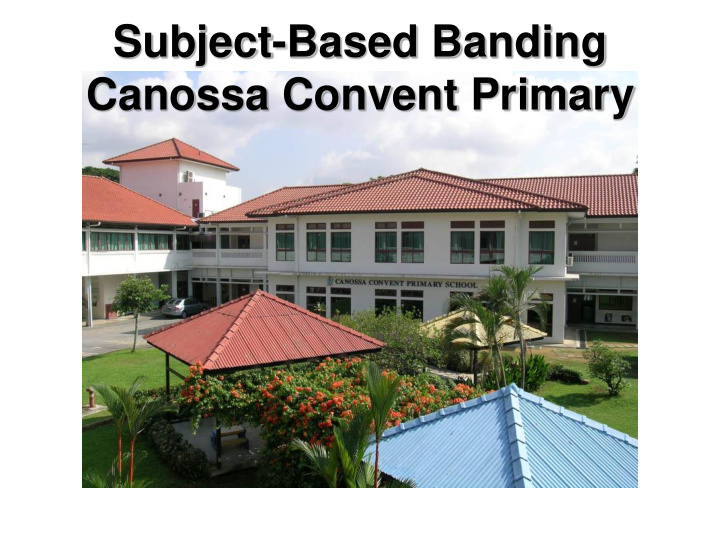



Subject-Based Banding Canossa Convent Primary
What is Subject-Based Banding (SBB) • Pupils do subjects at the levels that best meet their abilities • Subjects are offered at Standard and Foundation levels • No EM1, EM2 or EM3 classes
Why Subject-Based Banding? • Pupils have different abilities • Pupils have different abilities in different subjects • To enable pupils to study their strong subjects to the highest level possible • NOT INTENDED to provide a softer option • To encourage greater interaction among pupils with different strengths and abilities
How does s Sub ubje ject ct-based based Ba Band nding ing work? k?
How does s Sub ubje ject ct-based based Ba Band nding ing work? k?
Subjects at P5 English Offered at standard and foundation levels Mathematics Offered at standard and foundation levels Science Offered at standard and foundation levels Mother Offered at higher, standard and Tongue foundation levels
Some ome Gu Guid idin ing g Pr Prin incipl iples es • The school will have the best interest of each child in mind • The school will proceed on the basis of the `best fit’ for each child • All pupils will be encouraged to stretch themselves for the more challenging subject combinations instead of taking a perceived easy way out if they are able to do so
Selection Criteria • Progression to P5 will be based on the overall performance in 4 subjects: English, Maths, Science and Mother Tongue (where applicable) SA1 SA2 Total 40% 60% 100%
Subj Su bjec ect t Co Combi bina nations tions off ffered ed and d cr crite teria ria Combination Combination Criteria Criteria HMT For strong to very Fd Math A minority - For those who strong pupils with show a high capacity in EL Std EL Fd Sc strength in MTL even though they struggle with Std Ma Fd MT the other subjects Std Sc Std EL Std MT Std EL The majority of the Fd EL Weak pupils with strength in 1 cohort specific subject - MT Std Ma Fd Ma Strong to very strong Std Sc Fd Sc pupils Std MT Std MT Std EL A very small minority - Fd EL Weak Pupils For those who have Std Ma Fd Ma shown a consistent Std Sc Fd Sc pattern of struggling Fd MT Fd MT with MT despite best effort Other combinations may be offered, subject to availability of resources.
Allocation of course Criteria Combination Pass 4 subjects + Band 1 MT 4S+HMT Pass 3 or 4 subjects 4S Pass 2 subjects but failed MT 3S + FMT Pass EL/MT only EL/MT + 3F Fail all subjects 4F
Selection Criteria • Pass mark – 50 marks • Importance of EL • Importance of Mathematics
At the End of P4… • School makes recommendation for a subject combination • Parents have the option to accept the school’s recommendation or proceed with their own choice
At the end of P5… • School will choose Criteria Decision Pass 1 subject* Continue with P5 subject combination to P6 Fail all subjects 4 foundation subjects at P6 Pass HMT and get Band Continue with HMT at 2 for MT P6 *If a pupil scores less than 20 marks for a standard subject at end P5, she will be required to switch to the Foundation level for that subject.
Upgrading • The school will allow upgrades at the end of P5 based on the following: Criteria Decision Band 1 for any one Upgrade to standard level foundation subjects (85% at P6 for the subject and better) Band 1 for 3 or more Upgrade to 4 standard foundation subjects (85% subjects but have to re- and better) take P5 curriculum
Im Importan portant t Dat ates es Date Events 25 Jul Science Practical Test 27 & 28 Aug Oral Examinations (MT) 17 & 18 Sep Oral Examinations (EL) 27 Sep EL & MT Paper 1 4 Oct EL & MT Listening Comprehension 22 - 25 Oct SA2 Examinations November Exercise of Options
Help! How Shall I Choose? • Understand the abilities and needs of your child • Understand the scoring system for PSLE • Understand the future pathways for your child (e.g. to qualify for polytechnic education, a pass in Mathematics at `O’ levels is needed)
How will PSLE scores res be be ca calculate culated? d? • The PSLE scoring system remains unchanged • The raw mark for each subject is converted to a transformed score (T- score) – The T- score reflects the pupils’ standing relative to other pupils on a common scale – The Aggregate Score is the sum of the T- score in all subjects – Each subject carries equal weighting
How will PSLE scores res be be ca calculate culated? d? • The PSLE score takes into account the – content and demand of each subject – number of subjects taken
We CARE for each of our pupils • We will proceed in the best interest of every child • We will review cases at the margins carefully and ensure that we always give our pupils a more challenging combination so they can stretch • We will work with parents to ensure you understand the rationale of our recommendations
Q & A
Recommend
More recommend